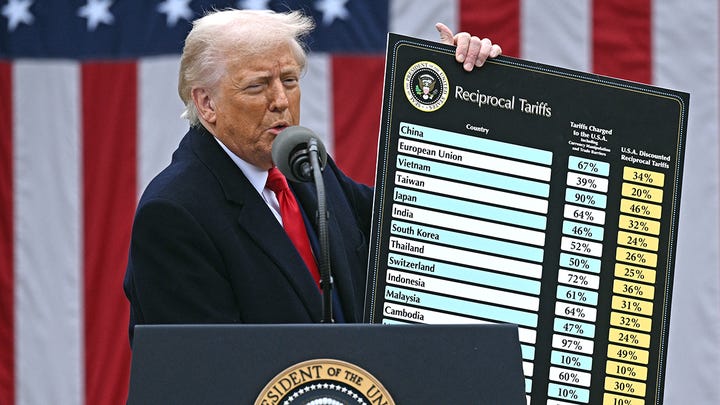Today's News: Trump’s Sweeping Global Tariffs Reshape U.S. Trade Policy
A sweeping new trade policy imposes a baseline 10% tariff on all imports to the U.S. and sharply higher country-specific duties on about 60 nations deemed to have unfair trade practices.
Photo: Brendan Smialowski/AFP via Getty Images
Overview
Date: April 2, 2025
Topic: Trump’s Sweeping Global Tariffs Reshape U.S. Trade Policy
Summary: President Donald Trump announced a sweeping new trade policy on April 2, 2025, imposing a baseline 10% tariff on all imports to the U.S. and sharply higher country-specific duties on about 60 nations deemed to have unfair trade practices. China faces a combined 54% tariff rate, the highest among U.S. trading partners, while the European Union, Japan, and India also face significant new levies. Canada and Mexico are exempt from the universal tariffs but remain subject to prior tariffs allegedly related to the fentanyl crisis. The move marks the most dramatic shift in global trade policy since WWII, claiming to bolster domestic manufacturing, reduce the trade deficit, and raise revenue. Markets reacted sharply, with futures plummeting amid fears of rising consumer prices and a global trade war. Critics warn of inflation, economic uncertainty, and retaliation, while supporters argue it could usher in a new era of American industrial strength.
Sources
The New York Times – Trump Announces Sweeping Tariffs on All Imports: Live Updates
CNN – Live updates: Trump announces sweeping new tariffs on imports on ‘Liberation Day’
Fox News – Trump touts return of the 'American Dream' in historic tariff announcement
The Washington Post – Trump preps major tariff hike as businesses and Wall Street brace for impact
Wall Street Journal – Tariffs Live Updates: Trump Unveils 10% Tariffs on All Imports; Stock Futures Plummet
NBC News – Trump announces sweeping tariffs on major trade partners — with some as high as 54%
Key Points
Baseline Tariff: A universal 10% tariff applies to all imports, effective April 5, with significantly higher rates for around 60 countries based on assessed trade imbalances and non-tariff barriers.
Country-Specific Tariffs: China (54%), EU (20%), India (26%), Japan (24%), Vietnam (46%), and others face “reciprocal” tariffs calibrated to match or undercut the trade barriers they impose on the U.S.
Exemptions: Canada and Mexico are excluded from the reciprocal tariffs but remain subject to prior 25% tariffs tied to drug and migration enforcement concerns.
Auto Tariffs: A new 25% tariff on all foreign automobiles took effect at midnight on April 2.
Economic Rationale: Trump framed tariffs as economic self-defense and a path to “economic independence,” aiming to restore U.S. manufacturing and reduce dependence on foreign supply chains.
Revenue Expectations: The administration expects to raise $700–$835 billion annually from tariffs, potentially using the funds to reduce taxes or the national debt.
Market Reaction: Stock index futures dropped sharply after the announcement, with the Nasdaq falling over 4% and economists predicting up to 2.5% added inflation due to tariffs.
Investor Sentiment: Gold surged, and investor volatility hedging increased, reflecting fears of prolonged economic uncertainty.
Unique Highlights
Fox News emphasized Trump’s populist messaging, invoking a return to “the American Dream” and spotlighting historical comparisons to 19th-century tariff-backed prosperity.
CNN provided granular detail on auto tariffs, noting potential price increases of $8,000–$20,000 per imported vehicle and projected consumer costs of $30 billion in the first year.
NBC News noted that the de minimis exemption was revoked for Chinese parcels under $800, affecting companies like Shein and Temu, and highlighted deteriorating consumer confidence.
The Wall Street Journal reported the administration's internal debate over a universal versus country-specific tariff structure and quantified inflationary risks and GDP impact.
The Washington Post detailed internal administration discussions leading to the final structure and outlined business concerns, including warnings from manufacturers like Xos and Babcock & Wilcox.
The New York Times highlighted investor confusion over how tariff rates were calculated and emphasized the historic scale and potential geopolitical fallout of the move.
Contrasting Details
Stock Market Impact: The New York Times reported a sharp market selloff, while CNN noted that U.S. markets actually closed higher on April 2 ahead of futures declines, suggesting timing differences in reporting.
Economic Tone: Fox News portrayed the move as a bold, revitalizing act for U.S. workers, while CNN, NBC News, and The Washington Post warned of significant inflationary risks and questioned the feasibility of Trump’s economic goals.
Trade Philosophy: The Wall Street Journal described a blend of reciprocal and universal tariffs, whereas CNN and The Washington Post stressed the administration’s evolving and sometimes contradictory rationale for the tariffs.
Investor Sentiment: The Wall Street Journal described growing investor pessimism and declining bank stocks, while Fox News omitted market impacts entirely and remained focused on the policy’s intended economic renaissance.
The Newsie Project is an experiment using AI tools to survey contemporary reporting. It attempts to summarize, compare, and contrast the reporting of the major US online news sources.
This is an evolving project. Tools, approaches, and output formats will change over time. The Newsie Project does not attempt to provide a definitive capsule of any news story. While the incidence of errors in these summaries is low, and I attempt to spot-check details, AI tools can hallucinate. Please click through and read the articles for details (some may be paywalled).


